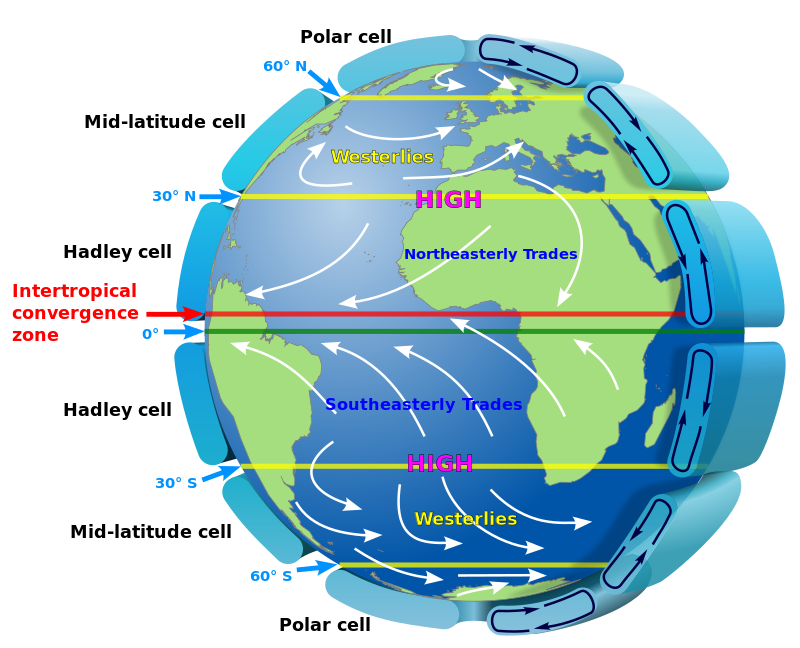TRICELLULAR MODEL // ATMOSPHERIC CIECULATION
A three cell model of meridional atmospheric circulation, also known as tricellular meridional atmospheric circulation,It l is a 2 dimensional model that give us a general understanding of how our atmosphere functions. It is a largel scale model which is based entirely upon the fact that there are recognisable insolation differences between the Equator and the Poles.
Tricellular Atmospheric Model
The tricellular model explains the meridional circulation of the atmosphere. According to this model, the global air circulation can be divided into three cells. These cells have been dividedbased entirely upon the fact that there are recognisable insolation differences between the Equator and the Poles.
It starts in the Doldrums, which is an area of intense low pressure found at the equator where the intense heating (convection) of the earth’s surface forces air to rise/upwell through the Troposphere. This area is known as the Inter Tropical Convergence zone (ITCZ).
HADLEY CELL
definition: As the air rises from the equator, it cools and condenses forming a belt of clouds. Some of this air migrates northwards in the upper Troposphere to equalise out the temperature and insolation differences of our globe. As this air migrates north it cools relative to the air around it, becomes denser and sinks to the Earth’s surface at around 30°N and S of the Equator, creating a band of high pressure. Some of this air migrates (because of Pressure gradient force) back to the low pressure area at the equator to complete the first cell of the system, the Hadley cell.
INVENTOR: in 1735 sir george hadley invented this cell.
LOCATION: The cell is located between 10-30 degree latitudes in both hemispheres.
FEATURE:
1.The cell is located between 10-30 degree latitudes in both hemispheres.
2.Th sun falls directly on the equator, so the temperature is very high at all time. Along the equator, rising air is caused by high insolation.
3.This is a solar cell that has been thermally induced as a result of high solar insolation.
4. They lead to upper air about 30 degrees latitude, which sinks and causes subtropical high pressure.
5. This cell is completed by the trade wind, which travels from the High Pressure toward the equator.
It's one of the most stable cells, and it's linked to a tropical monsoon and a desert climate.
FERREL CELL
DEFINITION: When this air reaches 60°N and S it reaches cold polar air that moves south. This is our second convergence zone where two surface air streams meet. This causes the warmer, less dense tropical air to rise through the atmosphere again creating an area of low surface pressure. It is this zone where we find the mid-latitude weather systems that blight British weather. Some of this air migrates back towards the Equator where it eventually sinks at 30°N and S to form the middle cell of the model, the Ferrell cell.
INVENTOR: In 1836 , scientist william ferrel invented ferrel cell.
LOCATION: This cell extends from 35 to 60-degree latitude in both hemispheres.
FEATURES:
1. This cell extends from 35 to 60-degree latitude in both hemispheres.
2.This is a thermally indirect cell and induced due to dynamic forces.
3. In this cell, the warm air is seen ascending from the polar front and breaking through near the tropopause.
4. The most important feature of this cell is that the polar front is more continuous in the middle troposphere.
5.There is a subsidence of air in the horse latitude from the tropical as well as polar front dells. On the surface, the circulation is completed by the westerly wind blowing toward the poleward side.
POLAR CELL
DEFINITION: The rest of the air moves s to the pole, where it cools and sinks creating high pressure in the Polar Regions and completing a weak polar cell.
LOCATION: 60-90 degree in both hemisphere
FEATURES:
1. It extends from 65 to 90 degrees in both hemispheres.
2. This is a thermally direct cell and is strongest during winter.
3.There is sinking air along the poles which moves towards the subpolar low as the easterly wind.
4. The easterly and westerly winds collide at the subpolar lows, causing the air to rise and complete the polar cell circulation
JOIN OUR TELEGRAM CHANNEL











0 Comments